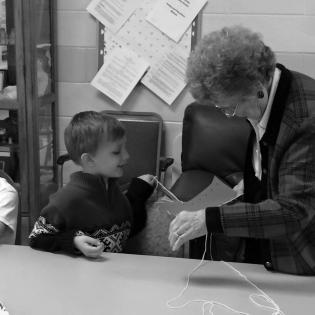Celebration of Living History
This lesson is a celebration to culminate this intergenerational project. The children make a final visit to the senior center or retirement home where all the participants gather for a snack and a farewell celebration. The children read aloud and give their published Living History Books to their senior friends. They debrief the entire project through journal entries.
The learners will:
- give a gift of a biography they wrote and illustrated to a senior friend
Instructions
Anticipatory Set:
Define the meaning of “community.” Brainstorm ways the seniors form a community. Discuss why it is valuable to form relationships with people of different backgrounds, ages and living situations within the larger community.
Children bring their completed books with them to visit and read to their senior partners. You may bring along cookies and other party elements. Remind children to be respectful and polite at all times.
The children read their book to their senior in a clear voice, loud enough to be heard. They will give the book to the senior to keep.
The senior friend may introduce the children to their friends as well. After a time of visiting and celebrating, they will say their thank-yous and their goodbyes.
Back to class, the children share reflections of the entire Living History project (see Assessment below).
Children and seniors may continue to write letters to each other through the school address. Note: children should not give out personal addresses or phone numbers without parental permission.
Read about the service-learning project called Nursing Home Visit by Nicholas A. Intermediate School in which students were taught using this Celebration of Living History lesson to guide student learning and action. “Teaching service is a valuable lesson we must teach our students. Allowing students to be a part of providing services can teach compassion, empathy, and kindness. Many students may not have the opportunity to participate in services like this at home.”
Philanthropy Framework
-
Strand PHIL.II Philanthropy and Civil Society
-
Standard PCS 02. Diverse Cultures
-
Benchmark E.2 Discuss the importance of respect for others.
-
-
Standard PCS 05. Philanthropy and Government
-
Benchmark E.13 Offer examples of community/social capital in school.
-
Benchmark E.7 Describe why the classroom, school, or neighborhood is a community governed by fundamental democratic principles.
-
-
-
Strand PHIL.IV Volunteering and Service
-
Standard VS 03. Providing Service
-
Benchmark E.1 Provide a needed service.
-
Benchmark E.4 Demonstrate the skills needed for the successful performance of the volunteer job.
-
Benchmark E.6 Describe the procedures and the importance of sensitivity to the people with whom students are working.
-
-
Standard VS 05. Integrating the Service Experience into Learning
-
Benchmark E.1 Describe the process of program evaluation.
-
Benchmark E.2 Evaluate progress on the service-learning project before, during, and after the project.
-
Benchmark E.3 Identify outcomes from the service.
-
-
